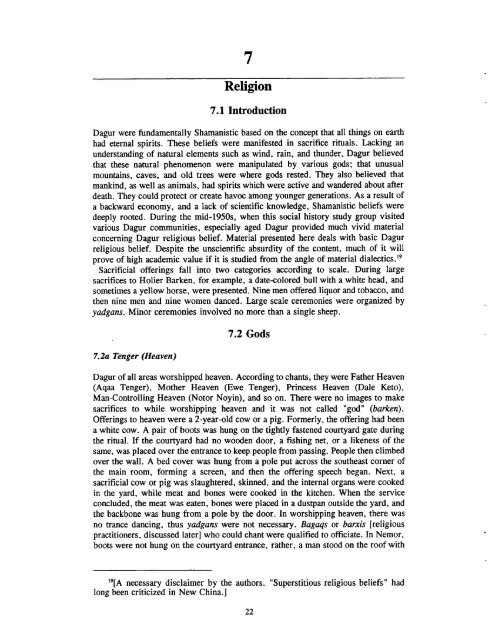China's Dagur Minority - Sino-Platonic Papers
China's Dagur Minority - Sino-Platonic Papers
China's Dagur Minority - Sino-Platonic Papers
You also want an ePaper? Increase the reach of your titles
YUMPU automatically turns print PDFs into web optimized ePapers that Google loves.
Religion7.1 Introduction<strong>Dagur</strong> were fundamentally Shamanistic based on the concept that all things on earthhad eternal spirits. These beliefs were manifested in sacrifice rituals. Lacking anunderstanding of natural elements such as wind, rain, and thunder, <strong>Dagur</strong> believedthat these natural phenomenon were manipulated by various gods; that unusualmountains, caves, and old trees were where gods rested. They also believed thatmankind, as well as animals, had spirits which were active and wandered about afterdeath. They could protect or create havoc among younger generations. As a result ofa backward economy, and a lack of scientific knowledge, Shamanistic beliefs weredeeply rooted. During the mid-1950s, when this social history study group visitedvarious <strong>Dagur</strong> communities, especially aged <strong>Dagur</strong> provided much vivid materialconcerning <strong>Dagur</strong> religious belief. Material presented here deals with basic <strong>Dagur</strong>religious belief. Despite the unscientific absurdity of the content, much of it willprove of high academic value if it is studied from the angle of material dialectics.19Sacrificial offerings fall into two categories according to scale. During largesacrifices to Holier Barken, for example, a datecolored bull with a white head, andsometimes a yellow horse, were presented. Nine men offered liquor and tobacco, andthen nine men and nine women danced. Large scale ceremonies were organized byyadgans. Minor ceremonies involved no more than a single sheep.7.2a Tenger (Heaven)7.2 Gods<strong>Dagur</strong> of all areas worshipped heaven. According to chants, they were Father Heaven(Aqaa Tenger), Mother Heaven (Ewe Tenger), Princess Heaven (Dale Keto),Man-Controlling Heaven (Notor Noyin), and so on. There were no images to makesacrifices to while worshipping heaven and it was not called "god" (barken).Offerings to heaven were a 2-year-old cow or a pig. Formerly, the offering had beena white cow. A pair of boots was hung on the tightly fastened courtyard gate duringthe ritual. If the courtyard had no wooden door, a fishing net, or a likeness of thesame, was placed over the entrance to keep people from passing. People then climbedover the wall. A bed cover was hung from a pole put across the southeast comer ofthe main room, forming a screen, and then the offering speech began. Next, asacrificial cow or pig was slaughtered, skinned, and the internal organs were cookedin the yard, while meat and bones were cooked in the kitchen. When the serviceconcluded, the meat was eaten, bones were placed in a dustpan outside the yard, andthe backbone was hung from a pole by the door. In worshipping heaven, there wasno trance dancing, thus yadgans were not necessary. Bagaqs or barxis [religiouspractitioners, discussed later] who could chant were qualified to officiate. In Nemor,boots were not hung on the courtyard entrance, rather, a man stood on the roof with"[A necessary disclaimer by the authors. "Superstitious religious beliefs" hadlong been criticized in New China.]
















